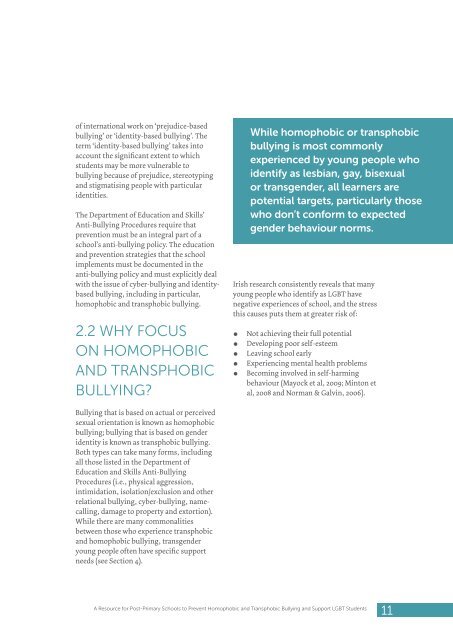‘BEING LGBT IN SCHOOL’
GLEN__Being_LGBT_in_School_10_Feb_2016_Web_3
GLEN__Being_LGBT_in_School_10_Feb_2016_Web_3
You also want an ePaper? Increase the reach of your titles
YUMPU automatically turns print PDFs into web optimized ePapers that Google loves.
of international work on ‘prejudice-based<br />
bullying’ or ‘identity-based bullying’. The<br />
term ‘identity-based bullying’ takes into<br />
account the significant extent to which<br />
students may be more vulnerable to<br />
bullying because of prejudice, stereotyping<br />
and stigmatising people with particular<br />
identities.<br />
The Department of Education and Skills’<br />
Anti-Bullying Procedures require that<br />
prevention must be an integral part of a<br />
school’s anti-bullying policy. The education<br />
and prevention strategies that the school<br />
implements must be documented in the<br />
anti-bullying policy and must explicitly deal<br />
with the issue of cyber-bullying and identitybased<br />
bullying, including in particular,<br />
homophobic and transphobic bullying.<br />
2.2 WHY FOCUS<br />
ON HOMOPHOBIC<br />
AND TRANSPHOBIC<br />
BULLY<strong>IN</strong>G?<br />
Irish research consistently reveals that many<br />
young people who identify as <strong>LGBT</strong> have<br />
negative experiences of school, and the stress<br />
this causes puts them at greater risk of:<br />
⚫⚫<br />
⚫⚫<br />
⚫⚫<br />
⚫⚫<br />
⚫⚫<br />
While homophobic or transphobic<br />
bullying is most commonly<br />
experienced by young people who<br />
identify as lesbian, gay, bisexual<br />
or transgender, all learners are<br />
potential targets, particularly those<br />
who don’t conform to expected<br />
gender behaviour norms.<br />
Not achieving their full potential<br />
Developing poor self-esteem<br />
Leaving school early<br />
Experiencing mental health problems<br />
Becoming involved in self-harming<br />
behaviour (Mayock et al, 2009; Minton et<br />
al, 2008 and Norman & Galvin, 2006).<br />
Bullying that is based on actual or perceived<br />
sexual orientation is known as homophobic<br />
bullying; bullying that is based on gender<br />
identity is known as transphobic bullying.<br />
Both types can take many forms, including<br />
all those listed in the Department of<br />
Education and Skills Anti-Bullying<br />
Procedures (i.e., physical aggression,<br />
intimidation, isolation/exclusion and other<br />
relational bullying, cyber-bullying, namecalling,<br />
damage to property and extortion).<br />
While there are many commonalities<br />
between those who experience transphobic<br />
and homophobic bullying, transgender<br />
young people often have specific support<br />
needs (see Section 4).<br />
A Resource for Post-Primary Schools to Prevent Homophobic and Transphobic Bullying and Support <strong>LGBT</strong> Students<br />
11


